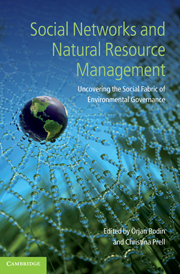 Social Networks and Natural Resource Management
Social Networks and Natural Resource Management Book contents
- Frontmatter
- Contents
- Contributors
- Foreword
- Part I Introduction
- Part II Case studies
- 4 Barriers and opportunities in transforming to sustainable governance: the role of key individuals
- 5 Social network analysis for stakeholder selection and the links to social learning and adaptive co-management
- 6 Who and how: engaging well-connected fishers in social networks to improve fisheries management and conservation
- 7 The effects of social network ties on the public’s satisfaction with forest management in British Columbia, Canada
- 8 Social network models for natural resource use and extraction
- 9 Friends or neighbors? Subgroup heterogeneity and the importance of bonding and bridging ties in natural resource governance
- 10 The role of individual attributes in the practice of information sharing among fishers from Loreto, BCS, Mexico
- 11 Transformative collective action: a network approach to transformative change in ecosystem-based management
- 12 Social networks, joint image building, and adaptability: the case of local fishery management
- 13 Agrarian communication networks: consequences for agroforestry
- Part III Summary and outlook
- Index
- References
6 - Who and how: engaging well-connected fishers in social networks to improve fisheries management and conservation
from Part II - Case studies
Published online by Cambridge University Press: 05 June 2012
- Frontmatter
- Contents
- Contributors
- Foreword
- Part I Introduction
- Part II Case studies
- 4 Barriers and opportunities in transforming to sustainable governance: the role of key individuals
- 5 Social network analysis for stakeholder selection and the links to social learning and adaptive co-management
- 6 Who and how: engaging well-connected fishers in social networks to improve fisheries management and conservation
- 7 The effects of social network ties on the public’s satisfaction with forest management in British Columbia, Canada
- 8 Social network models for natural resource use and extraction
- 9 Friends or neighbors? Subgroup heterogeneity and the importance of bonding and bridging ties in natural resource governance
- 10 The role of individual attributes in the practice of information sharing among fishers from Loreto, BCS, Mexico
- 11 Transformative collective action: a network approach to transformative change in ecosystem-based management
- 12 Social networks, joint image building, and adaptability: the case of local fishery management
- 13 Agrarian communication networks: consequences for agroforestry
- Part III Summary and outlook
- Index
- References
Summary
Introduction
The Loreto Bay National Marine Park was conceived as a people-oriented park where protection and sustainable use of marine resources were to be achieved. There have been advances towards these goals since the park was created, but the involvement of resource users in natural resource management and conservation still remains a challenge as in many other people-oriented parks worldwide (Brechin et al., 2002; Wilshusen et al., 2002; Adams et al., 2004). Many factors determine in what aspects, when, and how resource users could be involved in resource management and conservation. However, in all cases natural resource managers face the issue of identifying and involving resource users who could spread ideas and practices to improve natural resource management and conservation. This issue becomes increasingly relevant in large-scale initiatives (e.g. ecosystem-based management initiatives) where it is more effective and efficient to find representatives who can participate in planning processes and then communicate with, and engage, their peers (Layzer, 2008; Kubo and Supriyanto, 2010). Thus, the issue of identifying and involving resource users is also affected by the scale at which a management and conservation initiative is intended.
- Type
- Chapter
- Information
- Social Networks and Natural Resource ManagementUncovering the Social Fabric of Environmental Governance, pp. 119 - 146Publisher: Cambridge University PressPrint publication year: 2011
References
- 9
- Cited by


